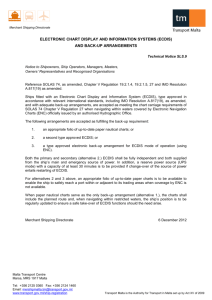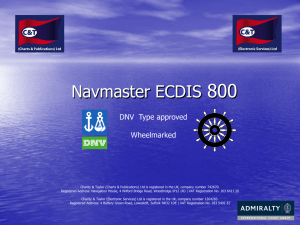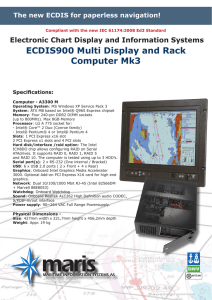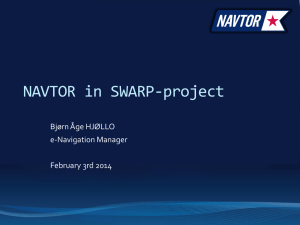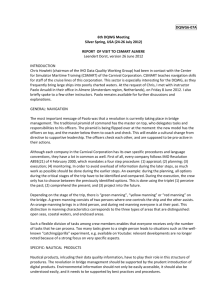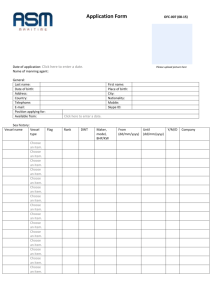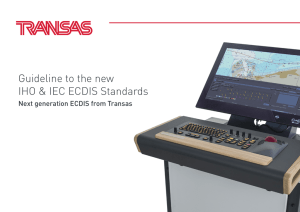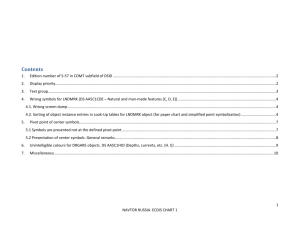Thông báo số 008TI/12TB của Cục Đăng kiểm Việt Nam về việc
advertisement
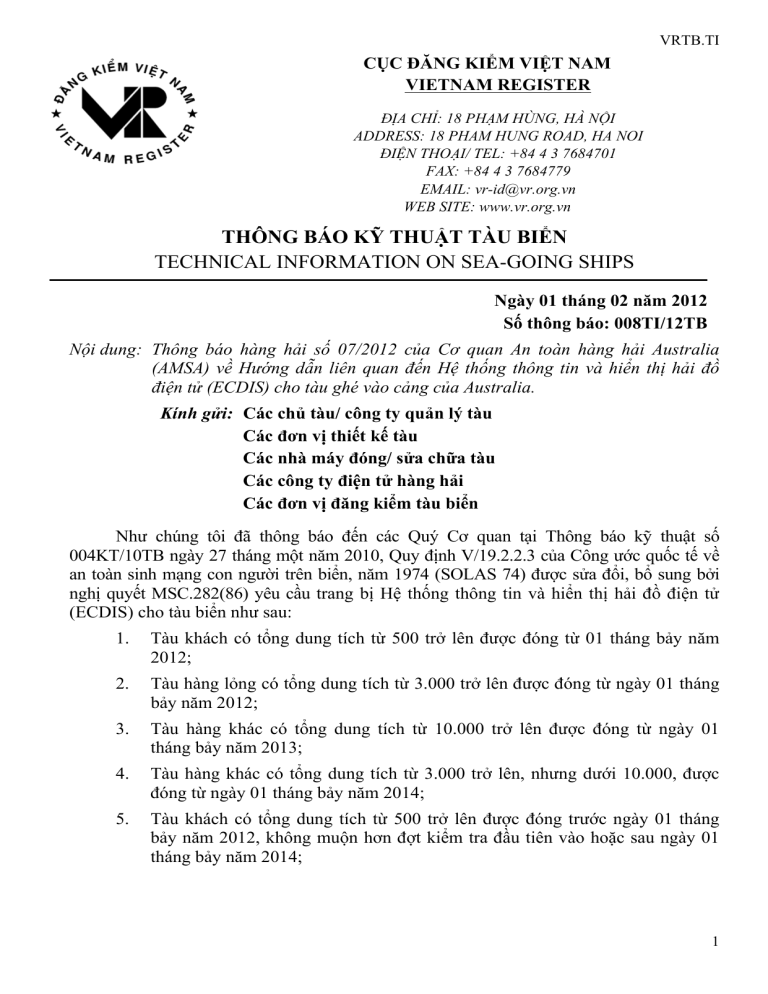
VRTB.TI CỤC ĐĂNG KIỂM VIỆT NAM VIETNAM REGISTER ĐỊA CHỈ: 18 PHẠM HÙNG, HÀ NỘI ADDRESS: 18 PHAM HUNG ROAD, HA NOI ĐIỆN THOẠI/ TEL: +84 4 3 7684701 FAX: +84 4 3 7684779 EMAIL: vr-id@vr.org.vn WEB SITE: www.vr.org.vn THÔNG BÁO KỸ THUẬT TÀU BIỂN TECHNICAL INFORMATION ON SEA-GOING SHIPS Ngày 01 tháng 02 năm 2012 Số thông báo: 008TI/12TB Nội dung: Thông báo hàng hải số 07/2012 của Cơ quan An toàn hàng hải Australia (AMSA) về Hướng dẫn liên quan đến Hệ thống thông tin và hiển thị hải đồ điện tử (ECDIS) cho tàu ghé vào cảng của Australia. Kính gửi: Các chủ tàu/ công ty quản lý tàu Các đơn vị thiết kế tàu Các nhà máy đóng/ sửa chữa tàu Các công ty điện tử hàng hải Các đơn vị đăng kiểm tàu biển Như chúng tôi đã thông báo đến các Quý Cơ quan tại Thông báo kỹ thuật số 004KT/10TB ngày 27 tháng một năm 2010, Quy định V/19.2.2.3 của Công ước quốc tế về an toàn sinh mạng con người trên biển, năm 1974 (SOLAS 74) được sửa đổi, bổ sung bởi nghị quyết MSC.282(86) yêu cầu trang bị Hệ thống thông tin và hiển thị hải đồ điện tử (ECDIS) cho tàu biển như sau: 1. Tàu khách có tổng dung tích từ 500 trở lên được đóng từ 01 tháng bảy năm 2012; 2. Tàu hàng lỏng có tổng dung tích từ 3.000 trở lên được đóng từ ngày 01 tháng bảy năm 2012; 3. Tàu hàng khác có tổng dung tích từ 10.000 trở lên được đóng từ ngày 01 tháng bảy năm 2013; 4. Tàu hàng khác có tổng dung tích từ 3.000 trở lên, nhưng dưới 10.000, được đóng từ ngày 01 tháng bảy năm 2014; 5. Tàu khách có tổng dung tích từ 500 trở lên được đóng trước ngày 01 tháng bảy năm 2012, không muộn hơn đợt kiểm tra đầu tiên vào hoặc sau ngày 01 tháng bảy năm 2014; 1 VRTB.TI 6. Tàu chở hàng lỏng có tổng dung tích từ 3.000 trở lên được đóng trước ngày 01 tháng bảy năm 2012, không muộn hơn đợt kiểm tra đầu tiên vào hoặc sau ngày 01 tháng bảy năm 2015; 7. Tàu hàng khác có tổng dung tích từ 50.000 trở lên được đóng trước ngày 01 tháng bảy năm 2013, không muộn hơn đợt kiểm tra đầu tiên vào hoặc sau ngày 01 tháng bảy năm 2016; 8. Tàu hàng khác có tổng dung tích từ 20.000 trở lên, nhưng dưới 50.000, được đóng trước ngày 01 tháng bảy năm 2013, không muộn hơn đợt kiểm tra đầu tiên vào hoặc sau ngày 01 tháng bảy năm 2017; 9. Tàu hàng khác có tổng dung tích từ 10.000 trở lên, nhưng dưới 20.000, được đóng trước ngày 01 tháng bảy năm 2013, không muộn hơn đợt kiểm tra đầu tiên vào hoặc sau ngày 01 tháng bảy năm 2018. Liên quan đến việc trang bị và sử dụng ECDIS, ngày 23 tháng 01 năm 2012, Cơ quan An toàn hàng hải Australia (AMSA) đã ban hành Thông báo hàng hải số 07/2012 “Hướng dẫn về ECDIS cho tàu ghé vào cảng của Australia”. Thông báo hàng hải nói trên của AMSA nhằm mục đích giải thích một số vấn đề cần lưu ý liên quan đến yêu cầu trang bị ECDIS, và đưa ra hướng dẫn đối với tàu được trang bị ECDIS khi ghé vào cảng của Australia. Trong Thông báo hàng hải này còn bao gồm các chỉ dẫn và 02 sơ đồ dòng chảy đề cập các vấn đề liên quan đến ECDIS sẽ được các nhân viên kiểm tra PSC của AMSA sử dụng khi kiểm tra tàu. Chúng tôi xin gửi kèm theo Thông báo kỹ thuật tàu biển này Thông báo hàng hải số 07/2012 của AMSA, và đề nghị các công ty quản lý tàu và sỹ quan hàng hải trên các tàu được trang bị ECDIS lưu ý áp dụng. Thông báo kỹ thuật này được nêu trong mục: Thông báo của VR/ Thông báo kỹ thuật TB của trang tin điện tử của Cục Đăng kiểm Việt Nam: http://www.vr.org.vn Nếu Quý Cơ quan cần thêm thông tin về vấn đề nêu trên, đề nghị vui lòng liên hệ: Cục Đăng kiểm Việt Nam Phòng Tàu biển Địa chỉ: 18 Phạm Hùng, Từ Liêm, Hà Nội Điện thoại: +84 4 37684701 (số máy lẻ: 522) Fax: +84 4 37684722 Thư điện tử: tuongnt@vr.org.vn Xin gửi đến các Quý Cơ quan lời chào trân trọng./. KT. CỤC TRƯỞNG PHÓ CỤC TRƯỞNG Nơi nhận: -Như trên; -Phòng QP, TB, CTB, CN; Trung tâm VRQC, TH; -Các chi cục đăng kiểm; -Lưu QP, TB./. Nguyễn Vũ Hải 2 MARINE NOTICE MARINE NOTICE 7/2012 Marine Notice 7/2012 Guidance on ECDIS for ships calling at Australian ports This notice aims to clarify some of the emerging issues relating to the carriage requirements for Electronic Chart Display and Information System (ECDIS) and provide guidance to ships fitted with ECDIS calling at Australian ports. Two flow charts that address ECDIS related issues and which will be used by AMSA’s Port State Control (PSC) inspectors, are attached. As mandatory carriage of ECDIS will be phased in from 1 July 2012, ship operators and navigating officers of ECDIS fitted ships are encouraged to take this guidance into account. 1. Cargo Ship Safety Equipment Certificate (Form E) Details of a ship’s navigational systems and equipment are recorded in Section 3 of Form E (Record of equipment - Cargo Ship Safety Equipment Certificate). The means of complying with SOLAS Chapter V Regulation 19 (i.e. paper charts and/or ECDIS) needs to be indicated on a ship’s Form E. If the ship uses ECDIS for navigation, Form E must clearly state the back-up arrangement in place. If a vessel requires flexibility in using either paper charts or ECDIS as the means of navigation, such an arrangement must be clearly indicated on Form E. In such cases, both paper charts and ECDIS must comply with SOLAS requirements. 2. Determining the means of navigation When determining the means of navigation being used, apart from an indication on Form E, AMSA’s PSC inspectors look for evidence of planning and presentation of the ship’s route for the completed or intended voyage and, of plotting and monitoring of the ship’s positions throughout the voyage. This information is cross-checked by the PSC inspectors against entries made in the ship’s deck log book. 3. Compliant ECDIS As per SOLAS Chapter V Regulations 18 and 19, for a ship to rely on ECDIS for navigation, the ECDIS installation must conform to the relevant IMO Performance Standards (as specified in Resolution A.817(19) (Performance Standards for ECDIS), as amended by MSC.232(82)). When ECDIS is being used for navigation, it must: i) be type approved, ii) be maintained to the latest applicable International Hydrographic Organization (IHO) standards, iii) use official Electronic Navigational Charts (ENC), and iv) have an adequate, independent back-up arrangement. 3.1 Type approval of ECDIS Type approval is the certification process that ECDIS equipment must undergo before it can be considered as complying with the IMO Performance Standards for ECDIS. The process is conducted by type approval organisations and marine Classification Societies. 3.2 Maintenance of ECDIS software An ECDIS that is not updated to the latest version of IHO standards may not meet the chart carriage requirement as set out in SOLAS Regulation V/19.2.1.4. IMO has issued SN.1/Circ 266/Rev.1 on the need to maintain ECDIS software. The following link provides a list of the latest IHO standards that apply to ECDIS equipment: www.iho.int/mtg_docs/enc/ECDIS-ENC_StdsIn_ Force.htm. Internet forfor all all current Marine Notices: www.amsa.gov.au Internetaddress address current Marine Notices: www.amsa.gov.au Page 1 Page 2 of of 44 MARINE NOTICE 3.2.1 ECDIS Data Presentation and Performance Check dataset IHO has produced an ECDIS Data Presentation and Performance Check dataset that allows mariners to check some important aspects of the operation of their ECDIS. This dataset contains two fictitious ENC cells which navigating officers can load into their ECDIS units to determine if the latest software is installed and if the units are operating optimally. If the check highlights a problem, accompanying guidance notes offer suggested courses of action. The check dataset and accompanying instructions can be downloaded from the IHO website at: www.iho.int/srv1/index. php?option=com_content&view=article&id=585:n ews&catid=166:1news-links&Itemid=828. 3.3 Carriage of official Electronic Navigational Charts Ships using ECDIS for navigation must carry Electronic Navigational Charts (ENC, which are official vector charts) or, where ENC data has not been published, Raster Navigational Charts (RNC, which are scanned, geo-referenced images of official paper charts). The ENCs and RNCs must be issued by, or on the authority of, a government, national Hydrographic Office or other relevant government institution. They must be of the latest available edition and be kept up to date using the latest available notices to mariners. 3.4 Back-up Arrangements for ECDIS Appendix 6 to IMO Resolution MSC.232(82) specifies the requirements for adequate, independent back-up arrangements. The main requirements are to enable a timely transfer to the back-up system during critical navigation situations and allow the vessel to be navigated safely until the termination of the voyage. AMSA considers the following will meet the back-up requirements for ECDIS: i) an independent, fully compliant second ECDIS unit, connected to ship’s main and emergency 7/2012 power supply and connected to systems providing continuous position fixing capability; or ii) adequate and up to date paper charts (including relevant large scale charts) necessary for the intended voyage. The back-up ECDIS must be loaded with relevant ENCs and the voyage plan before commencement of the voyage. Similarly, if paper charts are being used as the back up, they must be readily available and the voyage plan must be shown on them. In confined waters, the back-up arrangement must be ready for immediate use. 4. Mode of ECDIS operation A type approved ECDIS, when using current editions of ENC with the latest corrections available, operates in ECDIS mode. An alternative mode, known as Raster Chart Display System (RCDS) mode, can only be used if there are no suitable ENCs available for the area being navigated. In recent years, ENC coverage has increased rapidly. However, there may still be some areas (e.g. the polar regions) for which ENCs have not been issued. In Australia’s case, ENCs exist for all well-used coastal shipping routes and for all major ports. Hence, unless a ship will be operating in or transiting through an area for which there are no suitable ENCs, ECDIS should not need to be operated in RCDS mode in Australian waters. IMO has issued SN.1/Circ.207/Rev.1 to address the differences between RCDS and ECDIS. 5. Charts to be used in areas not adequately covered by ENCs ENC coverage of the world’s busiest ports and shipping routes connecting them, is substantially complete. Away from major shipping routes, ENCs may be limited to small scale coverage. In circumstances when greater detail is required, it may be necessary to use RNCs. When planning Internet address for all current Marine Notices: www.amsa.gov.au Page 2 of 4 MARINE NOTICE 7/2012 a passage in more remote areas, mariners should note: operational level, will be required to undertake ECDIS training, as described below: i) 7.1 Generic ECDIS training: All masters and officers in charge of a navigational watch should, as a minimum, complete generic ECDIS training that follows IMO Model Course 1.27 and conforms to the relevant STCW requirements. any caution embedded in an ENC, advising of the need to refer to larger scale charts for some areas, and ii) any areas within an ENC showing no data within that scale band (usage code). Where any significant area needs to be traversed using ECDIS in RCDS mode, mariners should critically consider the ability of their ECDIS to provide an adequate ‘look-ahead’ capability and, if necessary, acquire appropriate paper charts. When referring to RNC or appropriate paper charts, they should be maintained up to date in all cases. 6. SOLAS chart carriage requirement Until 1 July 2012 (and until 2018 for other ships, as per the implementation timetable set out in SOLAS), passenger ships, tankers and cargo ships of 500 gross tonnage and upwards engaged on international voyages, have three options to meet their SOLAS obligations for the carriage of nautical charts and publications: i) adequate and up to date paper charts necessary for the intended voyage; or ii) a type approved ECDIS operating with ENCs and a second IMO compliant ECDIS as an adequate and independent back-up; or iii) a type approved ECDIS operating with ENC and with adequate and up to date paper charts to serve as a back-up necessary to complete the intended voyage. 7. ECDIS training requirements The Manila Amendments to the International Convention on Standards of Training, Certification and Watchkeeping for Seafarers 1978 (STCW) and STCW Code will enter into force from 1st January 2012. This will make ECDIS training mandatory from 1 July 2013 for all officers serving on board ECDIS fitted ships. All officers in charge of a navigational watch, both at the management and 7.2 Type specific ECDIS training: In accordance with IMO Circ. SN.1/Circ 276 (Transitioning from paper chart to Electronic Chart Display and Information Systems (ECDIS) navigation) shipowners and operators should ensure that their ship masters and navigating officers are provided with a comprehensive familiarisation programme and type-specific training. ‘Trickle-down’ training (i.e. one officer training another) is not acceptable without a structured and formalised process being in place to facilitate such training. If the generic training includes training on the type of ECDIS equipment installed on board, then the training documentation must indicate this clearly. 7.3 On board familiarisation: In accordance with the ISM Code, the company should establish procedures to ensure that personnel are given proper familiarisation with their duties and equipment. ECDIS familiarisation training in the safe and effective use of shipboard ECDIS equipment should be clearly documented. 8. Port State control inspections With a phased carriage requirement for ECDIS commencing in 2012, AMSA’s PSC inspectors will increasingly focus on the means by which ships meet their SOLAS chart carriage requirements and the effectiveness with which the navigational task is being conducted. The following is a list of ECDIS issues which AMSA’s PSC inspectors pay close attention to: • appropriate declaration in Form E • ECDIS type approval certificate, confirming that the ship’s ECDIS complies with the relevant IMO performance standards and IEC test standards Internet address for all current Marine Notices: www.amsa.gov.au Page 2 of 4 MARINE NOTICE 7/2012 • maintenance of the ECDIS equipment to the latest applicable IHO standards 9. ECDIS flow charts • use of ENCs, including their latest editions and corrections to the latest available notices to mariners • adequate independent back-up arrangements (as detailed on Form E), ensuring safe navigation for the remainder of the voyage in the event of an ECDIS failure The attached flow charts outline ECDIS related implementation and operational issues and the related deficiencies that could be invoked by AMSA PSC inspectors. The assessment of any ECDIS related deficiencies (along with any remedial action determined) may vary, depending on the circumstances of each case. • documentary evidence of generic and type specific ECDIS training undertaken by the master and navigating officers • evidence of familiarisation training for the use of ECDIS equipment carried onboard • documented procedures for navigating officers using ECDIS • listing of ECDIS as critical equipment in the ship’s Safety Management System • conformance and alignment with input from sensors (e.g. heading, speed, rate of turn etc.) and its presentation on the ECDIS display • evidence of periodic tests and checks of the ECDIS equipment that need to be carried out as part of the Safety Management System Mick Kinley A/g Chief Executive Officer 23 January 2012 • demonstration of operational competency by the ships navigating officers (e.g. safety checking of a voyage plan) Australian Maritime Safety Authority GPO Box 2181 CANBERRA ACT 2601 Further enquiries regarding this marine notice can be addressed to: Manager Ship Inspections and Registration Maritime Operations Division Australian Maritime Safety Authority GPO Box 2181 CANBERRA ACT 2601 File No: 2011/2699 Internet address for all current Marine Notices: www.amsa.gov.au Page 2 of 4
